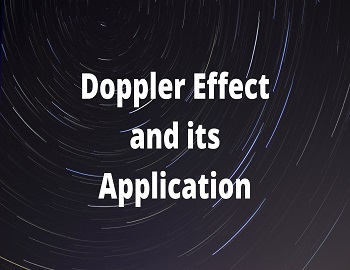Table of Contents
Doppler Effect and its Application:
What is Doppler Effect?
The frequency of a sound wave is equal to the frequency of the source which is producing the sound wave. It has been observed that the frequency of the sound waves produced by the same source can be changed by the motion of the source, or observer, or both. Suppose a man is standing on a railway platform and a train is approaching him. As the engine is approaching him the apparent pitch of the whistle of the engine increases.When the engine moves away from the man, the apparent pitch decreases. This change in the frequency of the sound of a moving object which is otherwise giving regular vibrations is called the Doppler effect. Thus, the Doppler effect describes the change in the observed frequency of a wave, arising from a relative motion of the source of waves and the observer.
Application of Doppler Effect:
(1) Use of Radar- Doppler’s effect is directly used in radar stations to find the direction and speed of a moving aeroplane. A radar transmits radio waves of a particular frequency in the air (just like sound waves but with much higher frequencies), that may hit the suspected aeroplane and reflect back. The reflected wave is received back at the radar station and is electronically analyzed to know its frequency. The frequency of the reflected wave is more than that of the transmitted one if the plane is approaching the radar station and vice versa. The speed of this aeroplane is also found by using Doppler’s equation. Thus, the long-range or short-range missiles can be properly aimed at enemy’s aircraft to destroy them during war times.
(2) Use of Sonar- Similar method as described above for radar, is used to find the speed and direction of a moving submarine inside water by using sonar. The equipment transmits high-frequency ultrasonic waves inside the water (instead of radio waves of radar) which get reflected back by the moving submarines.
(3) Light Waves- By applying the Doppler effect to the light waves emitted by a star in a galaxy, we can find out whether the star is moving towards the earth or away from the earth. This is because if a star is moving towards the earth, then the frequency of light emitted by it will increase gradually and shift towards the violet end of the visible spectrum VIBGYOR (because the violet end of the visible spectrum has a higher frequency). This is called violet shift. On the other hand, if a star is receding (moving away) from us, then the frequency of light emitted by it will decrease and shift towards the red end of the visible spectrum VIBGYOR (because the red end of the visible spectrum has a lower frequency). It is this shift in frequency that is called redshift. From this discussion, we conclude that the violet shift indicates the approaching of stars towards us whereas the redshift indicates the recession of stars. E. Hubble’s observations of the red-shift in the spectrum of light coming from the far-off galaxies led him to conclude that the galaxies are moving away from one another at a great speed. Thus, when the Doppler effect is applied to light waves coming from various stars in the galaxies, it tells us that the various galaxies are receding from us (moving away from us) with greater and greater speeds. And it was the scientist E. Hubble who carefully studied the light emitted by different galaxies and by using the Doppler effect, came to the conclusion that all galaxies move away from one another continuously.









Comments (No)